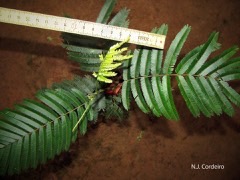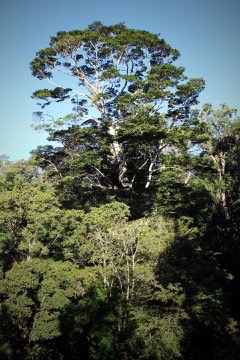 |
|
flickr.com / TanzaniaPlantCollaboration |
 |
| flickr.com / TanzaniaPlantCollaboration |
Translate this page:
Summary
Physical Characteristics

 Newtonia buchananii is a deciduous Tree growing to 25 m (82ft) by 20 m (65ft) at a fast rate.
Newtonia buchananii is a deciduous Tree growing to 25 m (82ft) by 20 m (65ft) at a fast rate.
See above for USDA hardiness. It is hardy to UK zone 10. The flowers are pollinated by Bees.
Suitable for: light (sandy), medium (loamy) and heavy (clay) soils and prefers well-drained soil. Suitable pH: mildly acid, neutral and basic (mildly alkaline) soils. It cannot grow in the shade. It prefers moist soil.
UK Hardiness Map
US Hardiness Map
Synonyms
Piptadenia buchananii Baker f.
Plant Habitats
Edible Uses
References More on Edible Uses
Medicinal Uses
Plants For A Future can not take any responsibility for any adverse effects from the use of plants. Always seek advice from a professional before using a plant medicinally.
The bark is used as an aphrodisiac[299 ]. In DR Congo an air-dried bark decoction is applied as powder to treat abscesses[299 ].
References More on Medicinal Uses
The Bookshop: Edible Plant Books
Our Latest books on Perennial Plants For Food Forests and Permaculture Gardens in paperback or digital formats.

Edible Tropical Plants
Food Forest Plants for Hotter Conditions: 250+ Plants For Tropical Food Forests & Permaculture Gardens.
More

Edible Temperate Plants
Plants for Your Food Forest: 500 Plants for Temperate Food Forests & Permaculture Gardens.
More

More Books
PFAF have eight books available in paperback and digital formats. Browse the shop for more information.
Shop Now
Other Uses
Fodder
Agroforestry Uses: Newtonia buchananii is planted as a shade tree in coffee, tea and cocoa plantations; the crown gives a rather light shade[299 ]. It is planted along rivers in order to stabilize the banks[299 , 303 ]. The leaves are used as mulch[299 ]. The flowers are a good source of nectar and pollen for bees[299 ]. Other Uses: A yellow-brown resin exudes from the bark when cut[303 ]. The heartwood is pale brown, darkening to golden brown upon exposure; distinctly demarcated from the 5 - 15cm thick band of greyish white sapwood. The grain is interlocked; texture moderately coarse to coarse; the wood has some stripe or ribbon figure and is lustrous. The wood is medium-weight; fairly soft to moderately hard; not durable to moderately durable - it shows moderate resistance to termite attacks, but is susceptible to powder-post beetle, pinhole borer and marine borer attacks. However, the wood is reportedly durable in fresh water, and is for that reason much used for making canoes in Lake Victoria. It air dries and kiln dries satisfactorily, with little distortion but with some risk of checking. After drying, the wood is moderately stable in service. It is easy to saw, but with some tendency to split due to growth stresses; it works fairly easily by hand and machine tools, but mortising and boring are somewhat difficult; a cutting angle of 10° and sharp edges are recommended for planing of quarter-sawn stock, but for flat-sawn pieces an angle of 30° is sufficient; the use of a filler is needed to obtain a good finish; it holds screws and nails well, but there is a tendency to splitting; pre-boring is recommended; it glues more or less satisfactorily and peels well. The boles have a tendency to split during felling operations. Freshly harvested logs are liable to insect attacks and should be removed from the forest soon after felling to avoid damage to the wood. The wood is used for tool handles, implements, carpentry, joinery, cabinet work, doors, door frames, bridges, boat building, vehicle bodies and fencing. It is suitable for light construction, flooring, interior trim, boxes, crates, veneer and plywood. It is used traditionally to make dugout canoes[299 , 364 ]. The wood is a good quality fuel and is used for charcoal production[299 , 303 , 364 ]. A fodder plant.
Special Uses
Carbon Farming
References More on Other Uses
Cultivation details
Fodder: Pod Regional Crop
A plant of the moist to wet tropics, where it can be found at elevations from 600 - 2,200 metres. It occurs in regions with a mean annual rainfall within the range 1,100 - 3,000mm and a mean annual temperature of 17 - 27°c[299 , 303 ]. In general, seedlings grow slowly and have low survival rates. This means that special care is needed in the early years. Direct sowing has been tried in Tanzania, but survival of seedlings was low, up to only 26% after 10 years. Once established however, which is usually after 1 - 3 years, the young trees can grow fairly fast[299 ]. Locally, trees may be found flowering throughout the year[299 ]. The winged seeds are mainly dispersed by wind, but distribution by water and birds is also possible[299 ]. It has been reported that the tree is relatively short lived[299 ]. Although many species within the family Fabaceae have a symbiotic relationship with soil bacteria, this species is said to be devoid of such a relationship and therefore does not fix atmospheric nitrogen[755 ].
Carbon Farming
-
Fodder: Pod
Fodder plants with pods.
-
Regional Crop
These crops have been domesticated and cultivated regionally but have not been adopted elsewhere and are typically not traded globally, Examples in this broad category include perennial cottons and many nuts and staple fruits.
References Carbon Farming Information and Carbon Sequestration Information
Temperature Converter
Type a value in the Celsius field to convert the value to Fahrenheit:
Fahrenheit:
The PFAF Bookshop
Plants For A Future have a number of books available in paperback and digital form. Book titles include Edible Plants, Edible Perennials, Edible Trees,Edible Shrubs, Woodland Gardening, and Temperate Food Forest Plants. Our new book is Food Forest Plants For Hotter Conditions (Tropical and Sub-Tropical).
Shop Now
Plant Propagation
Seed - they do not show any dormancy and usually germinate in 3 - 4 weeks, with up to 70% germination rates and exceptionally to 90%[299 ]. The seeds lose their viability quickly, and cannot be stored for more than a few weeks at room temperature. They are very susceptible to insect attack[299 ]. Root suckers can also be used for propagation, and wildlings are occasionally collected for planting[299 ].
Other Names
If available other names are mentioned here
English - newtonia,forest newtonia; Luganda - mpewere; Swahili - mnyasa; Trade name - mufomoti
Native Range
AFRICA: Tanzania, Uganda, Cameroon (west), Democratic Republic of the Congo, Angola, Mozambique, Malawi, Zambia, Zimbabwe
Weed Potential
Right plant wrong place. We are currently updating this section.
Please note that a plant may be invasive in one area but may not in your area so it's worth checking.
None Known
Conservation Status
IUCN Red List of Threatened Plants Status : This taxon has not yet been assessed

Growth: S = slow M = medium F = fast. Soil: L = light (sandy) M = medium H = heavy (clay). pH: A = acid N = neutral B = basic (alkaline). Shade: F = full shade S = semi-shade N = no shade. Moisture: D = dry M = Moist We = wet Wa = water.
Now available:
Food Forest Plants for Mediterranean Conditions
350+ Perennial Plants For Mediterranean and Drier Food Forests and Permaculture Gardens.
[Paperback and eBook]
This is the third in Plants For A Future's series of plant guides for food forests tailored to
specific climate zones. Following volumes on temperate and tropical ecosystems, this book focuses
on species suited to Mediterranean conditions—regions with hot, dry summers and cool, wet winters,
often facing the added challenge of climate change.
Read More
Expert comment
Author
(Baker f.) G.C.C.Gilbert & Boutique
Botanical References
Links / References
For a list of references used on this page please go here
A special thanks to Ken Fern for some of the information used on this page.
Readers comment
| Add a comment |
|
If you have important information about this plant that may help other users please add a comment or link below. Only comments or links that are felt to be directly relevant to a plant will be included. If you think a comment/link or information contained on this page is inaccurate or misleading we would welcome your feedback at [email protected]. If you have questions about a plant please use the Forum on this website as we do not have the resources to answer questions ourselves.
* Please note: the comments by website users are not necessarily those held by PFAF and may give misleading or inaccurate information.
To leave a comment please Register or login here All comments need to be approved so will not appear immediately.
|
Subject : Newtonia buchananii
|
|
|
|